In November of 2007, I will celebrate the 30th anniversary of the carving of my first miniature figurine, "Lady with an Urn." Since that November of 1977, I have had a front row seat to my own Olszewski resale market. Prior to that time, I created art as an individual. After that November, I created work under the umbrella of Olszewski Studios and have seen Olszewski Studios [my company] evolve through three major transformations. Each era is unique and the differences in these eras have made, will continue to make a major impact on the future and still evolving Olszewski resale market. In writing from a historical perspective, I hope to help collectors gain insight into why the values of the work in the Olszewski resale market are so varied, and that rarity or resale values high or low, is not simply the result of the size of a limited edition. To move forward, we need to identify some important components that make the Olszewski market what it is.
The glue that binds the 4 eras (identified in Figure 1 below) together is the artistic life work and evolution of one artist. During these years, I solely have owned the conceptual problems associated with the work and have enjoyed the results of the success of the works and have also paid the price of the failures. My name  on a work means that I stand behind the integrity of the work and am willing to answer to the market for all good and bad associated with the completed pieces. Because of this, I have retained complete control of all listed works from beginning to end including final approval of the master sculpt, color and production quality.
on a work means that I stand behind the integrity of the work and am willing to answer to the market for all good and bad associated with the completed pieces. Because of this, I have retained complete control of all listed works from beginning to end including final approval of the master sculpt, color and production quality.
In an upcoming graphic layout (see Figure 1 below) we can see the path that all pieces travel beginning in the mind of the artist to the resale of the collector. In the graphic we can also see a line that shows where my control ends and the control of outside influences begin. It is important for collectors to note that the resale value of the work is always impacted by the preceding phases. My front row seat has allowed me to follow every piece I have ever made through this process and watch the results. It is this knowledge I hope to share with you. What I have learned is that knowledge is the key to obtaining the best value in the resale market of Olszewski.
This does not mean that I promote investing, but that I believe that knowledge of Olszewski history may lead to getting a better value on an item when buying and getting the proper value on an item you are selling. The foundation of this knowledge is found in the comprehensive lists (found on the Olszewski Web-Site) that span all 4 eras. Although the resale values on many works are incomplete, there is enough information for collectors to do some comparisons on year of issue, edition size, first release and resale values of similar work. It may take some effort, but if you take your collection seriously, it will be worth it.
To highlight this point, in 1994, I was at a collectible show in Los Angeles. A collector brought in a group of pieces for me to sign. One of the pieces had been released in 1979 and it was the first time since that era I had been asked to sign one. I asked how he came to find it and he told me of an estate sale purchase of a shoebox full of an assortment of Olszewski's. He paid $30 for the lot. Some six months earlier, I saw the same item sell for $5,000. Only 29 of them exist and the piece is well marked with an edition size and the name Olszewski. He knew what he was buying, the sellers didn't. It's too bad, that if the seller needed the money they didn't get a better value, but that's collecting.
Before we get to the chart, I would like to raise one more question at this point concerning the resale market. What is the piece we just described worth? Is it worth $30 or $5,000? This same story is repeated many times on the Antiques Road Show. Because of what I know of the history of the piece, I believe both collectors got a good value on their purchase. Yes, resale prices on Olszewski are all over the place, but don't assume that if you see a work sold for less than you paid for it, that your collection is worth less. Instead of reacting, use your knowledge to filter the things you see happening.
Using the following chart shown in Figure 1 below, we will show just how a piece follows the process of a work coming to market can effect the resale values years later.
Figure 1 From the Olszewski Concept to the Collector
Olszewski Production
ERAS

|
ERA
I
Paintings
1960-1977 |
ERA II
Pre-Goebel
1977-1979 |
ERA III
Goebel
Miniatures
1979-2004 |
ERA IV
Olszewski Studios
1994 - Today
|
Olszewski Production
Phases

|
Personal Art
Jewel boxes
Story-Time |
Luminiart
Story-Time |
Disneyland MS
Disney World MS |
A - Concept |
|
|
|
|
|
|
|
B - Master Sculpt and Color Masters |
|
|
|
|
|
|
|
C - Production |
|
|
|
|
|
|
|
D - Sales to Distributors |
N/A |
N/A |
N/A |
Goebel USA
Schmid |
N/A |
Harmony Ball
|
Disneyland
and Disney World
|
E - Shops |
N/A |
N/A |
Shops |
Shops |
Shops |
Shops |
F1 - Antique Trader, Flea Market, Estate Sales, Shop Resale, eBay
F2- Antique Trader, Flea Market, Estate Sales, Shop Resale, eBay
|
N/A |
N/A |
N/A
|
F1 |
N/A |
F1 |
N/A |
F1 |
Collectors |
Collectors |
Collectors |
Collectors |
Collectors |
Collectors |
Collectors |
NA |
F2 |
F2 |
F2 |
F2 |
F2 |
F2 |
Collectors |
Collectors |
Collectors |
Collectors |
Collectors |
Collectors |
| H - Long-Term Resale Value Impact Examples |
H1
Dollhouse |
|
|
|
H5
Kinderway |
H6
Steamboat Willie
Premiere
|
|
?
|
A -Concept When a work is commissioned or approved for a company, it is standard policy and courtesy that the company be able to have influence on the idea. However, if the artist name is on the base or packaging, then the artist has the greater say in how the concept will go. Work without an artist name is considered work for hire and the company has the say on how they piece will look. Having the  name on a work ensures the collector of my commitment to the concept and quality control at all phases of the project. This is why it is important that collectors identify on the work the name
name on a work ensures the collector of my commitment to the concept and quality control at all phases of the project. This is why it is important that collectors identify on the work the name  . Collectors should know that there are projects that have not come to fruition because I couldn't get behind the initial concept and put my name on the item. To clarify this further, we plan to publish photos of work attributed to
. Collectors should know that there are projects that have not come to fruition because I couldn't get behind the initial concept and put my name on the item. To clarify this further, we plan to publish photos of work attributed to  that are not by Olszewski.
that are not by Olszewski.
B - Master Sculpt and Color Masters The final look of the sculpt and color is determined here. If this is done in concert with a company then it is proper that the company approve the final work as well.
C - Production Over these 30 years, and except for one short period of time, I have retained final production quality control on all Olszewski work. Production studios can have a great impact on the resale market. In the trade it is know as MOQ (Minimum Order Quantity) and is the lowest number of pieces that they will run in order to remain profitable. The distributor tries to strike a happy balance between the minimum run and guessing what the market will sell. Guess too low and the market will not have enough, and demand a rerun. However, the rerun may not be enough to sell out all the pieces from a second minimum run and you end up with too much inventory. In the majority of cases there is never a second run and the true market demand is never fulfilled. Because of this, my advice to collectors is to buy your pieces as soon as the pieces are released, especially when pieces are part of a larger ongoing collection. This is one of the most difficult decisions to make for the distributor, and has a major impact on the future resale market, good and bad.
D - Sales to Distributors (production and distributors are closely intertwined) Collectors can see at this point that in eras III and IV, the number of pieces produced in a production run fall under the responsibility of the companies I am designing for. However, if I choose to sell the work to shops myself, such as under the Disney license for "Story-Time," then we at Olszewski Studios set and managed the production run size. This decision, how much to order is strictly business and will have a major impact on the resale market later. Again it is important to know that all company's are subject to the minimum run size order that were described in Production (Section C Production) above.
It is also at this phase that the issue price and whether the work is an open or limited edition is set. The edition size is also set at this phase. Factoring MOQs, design, and market conditions mixed together is difficult and decisions made today will affect the resale market later. The greatest impact on inventory control has been the introduction of the computer to monitor inventories, and has resulted in a no tolerance policy for excess inventories at distributors and at shops as well. The distributors and shops have caught on to this but the collectors have not. Any prodding by shop owners to purchase an item now sounds like the same old scare tactics from years ago, but in reality the combination of MOQs and computers has made for a new market of more designs but shortened availability of individual items.
E - Shop Owners The industry of shop owners can only be as good as the industry they work in. For years the collectibles industry prospered, dealer organizations and manufacturers had clout and put on many wonderful shows such as the South Bend and Rosemont shows. However, the most important thing that never came to pass was the setting of industry standards, important questions such as:What is a collectible?, What is a gift?, What defines a limited edition?, Is there a difference between an edition of 10 and an edition of 10,000?, Does "firing days" qualify as a limited edition?, Are there any ethical ground rules for a dealer such as discounting work?, and, many more.
Collectible Dealer Standards
The Jewelry industry has standards. I know because I have produced jewelry in gold and silver, with diamonds and precious stones as well. Worldwide all collectors and buyers can be sure, because of the standards set by the jewelry industry, that they are protected. Like a Jeweler, are there classes [or certifications] that a collectible dealer can take to qualify a dealer into a higher status? Locally we have a Jeweler that is a Certified Gemologist and any serious discussion of stone appraisals goes to him.
Could the industry standards have been set with the manufacturers and dealers together? Maybe the dealer, like the gemologists could have risen to the ranks of certified appraisers of collectibles. This would have led to accountability on everyone's part, keeping records of the history of companies and artists and even possibly establishing a museum of collectible art that would live on beyond us all.
Now, why would I say this? I say this because the discounting of work below the retail price in the past has been set in motion by the actions of the distributors, not all, but some, operating without standards, and continued discounting by shop owners, some not all also operating without standards. Collectors rarely can sell below retail because they rarely buy under retail.
Setting industry standards would have had a positive impact on the thriving collectible market. To buy the work at retail and see it discounted is painful. I agree. To create the work and see it discounted is equally painful.
The next question is - is it possible to have your work discounted and survive? Yes. I'm living proof. Why? Because the long-term value of my work is impacted by more things than a temporary low price. This brings us to the next segment of the chart.
|
F1 & 2 - Antique Trader, Flea Markets, Estate Sales, eBay Most of this discounted work is sold by Dealers (shops), or by a family that has inherited the work but not the appreciation of it. To get a fair price on something you inherit doesn't mean you have to love it, but as I said earlier, knowledge goes a long way. Until just recently when we published our web-site no place existed for collectors to visit and reference the complete history of Olszewski. We hope that by historically recording all information on Olszewski that the site will help collectors to document, track and value their collections. Until now the only authoritative reference was the excellent but dated book by Dick Hunt published in 1986 that sold 10,000 copies.
A new avenue for resale was the internet, specifically eBay and it has taken me a long time to understand what I think about it. Previously, it was only product changing hands through shop owners, shows, and publications such as the Antique Trader Magazine. I just set up and started using a computer in March of 2006. This means that I have not had an opportunity to visit eBay until just recently. What I did instead was listen to the comments of collectors I met at shows. The big eBay sell of Olszewski began when I left Goebel in 1994. After I left, and with no way to sell the inventory, Goebel dumped the inventory. I knew this would happen before I left and knew if I continued to create quality work and move the art form forward, I would survive it. I also knew that only some of the pieces were overstocked and the others that were rare would continue to be rare.
At my shows, as I was signing individual works that collectors brought in, I began asking how they came to come across so many pieces. Most collectors didn't want to offend me and would only open up if I asked about eBay. Once this bridge was crossed, collectors were sure to let me know how happy they were to fill in their collections at a good value. This has been a consistent experience for me. Finally, while in a booth at the Rosemont Show in Chicago, I met an eBay representative. They inquired if I could sell the Disney Story-Time on their site like a shop? The answer was "no" as we were restricted by our Disney contract from doing so. I next asked "Why would they request this?" The representative went on to tell me that eBay tracks all sales, and at that time " I was the most collected artist on all of eBay." I was shocked, and didn't know what to think of it. It has taken me some time to cook it out. First, the Goebel inventory has moved through eBay like a pig through a python. Again, I have found that what is rare is still rare, and what is not rare is not. More and more, I am hearing that pieces that once went for low prices are harder to come across and are now at higher prices. The next big thing I have found is this. eBay, because of the lower prices for the dumped inventory, has started a whole new group of collectors that could not have afforded to begin collecting Olszewski before. Who would have thought this would have been the result?
Today, with the end of Story-Time we are facing a new opportunity for collectors. I suggest that collector's fill-in their Story-Time's collections now, as the final inventory is small and not even close to the Goebel inventories of 1994.
As a final note in this section, we are going to take individual pieces and track why some of the Olszewski work is so hard to find and why some is so available at low prices? Reading these individual histories of pieces and collections is going to be a valuable tool in increasing your knowledge, as a collector, seller or buyer. As I said this took me a long time to come to understand what was happening in the Olszewski resale market. Discounting alone would not affect availability and price fluctuations. If the work isn't interesting to a collector, it will not be purchased no matter how low the price is.
As I said this took me a long time to come to deal with. Would discounting alone do this? I don’t think so. If the work isn’t interesting to a collector, it will not be purchased no matter how low the price is. So after some listening over 12 years at shows I think I have come across the main ingredient for this phenomenon. One word: Diversity – if you look over the 4 eras you will find a huge range of styles and subject matter released in categories that people are really interested in. A person that visits the site might be first interested in Cinderella. At a show in Houston, I met a young lady maybe 30 [years of age] that had purchased the Cinderella Castle I did for Disney World. She had stopped in to purchase the Story-Time Cinderella pieces. While at the shop, I had my slide show and included the Goebel Miniatures Cinderella set from 1986. Her immediate reaction was that she would start to look for it. This was last year [2005] and guessing her age at 30 places her at the age of 9 when I carved it in 1986.
I must insert my comments about shop owners and standards. If collectible shop owners were certified appraisers with knowledge, couldn't shop owners today be selling some of the best collectibles from the past (like Goebel/Cinderella) just like antique shops? Does everything in a collectible shop have to be new? This tells me the industry without standards does not value the work it sells! Imagine a collectible shop selling antique collectibles that had a verifiable history. How great would that be? - Well it won't happen in my lifetime, but, my goal is to historically document my work on this web-site so it can be collected long-term - and the young lady might find it at an antique collectible shop in the future.
My last comment on diversity is this. The odds are good that most people who like small well-done items would find an area of interest in one of the 4 eras of my career. The entry level interest might begin with one of the great Disney films or Wizard of Oz and eventually split off into the birds or one of the 3 Nativity sets or Night Before Christmas sets I have done.
Collectors are still enthusiastically collecting. I meet them all the time. What has changed is where they shop. If the industry redefines itself, I am certain that they will find a happy robust base of people ready to collect.
G - Collectors No formal study has been done on this. My conclusions are the result of traveling and meeting with collectors in over 750 shows since 1978.
- These people like small well-done work.
- The age range depending on subject is from children to seniors.
- The Olszewski Collector can be, but is not described as wealthy, but earns enough to make the purchases.
- The Olszewski Collector is intelligent and perceptive, and remembers everything I say.
- The Olszewski Collector enjoys meeting other Olszewski Collectors and enjoys talking about their common love of small well-done work.
- The majority of the Olszewski Collectors do not buy for investment. Buying for investment is just not where these people are.
- Many of the Olszewski Collectors will tolerate discounting if it will help them finish out some of their missing work.
- Buying a discounted piece is seen as getting a good value as they usually have a true appreciation of the craftsmanship.
- The majority of Olszewski Collectors trust me for my integrity and know how much I love the art form of miniaturization.
H - Long-Term Resale Value Impact Examples
H1 Long-Term Resale Value Impacted by
|
Limited Edition of 3 |
ERA I - 1960 - 1977 Paintings "Meredith Hayden Dollhouse"
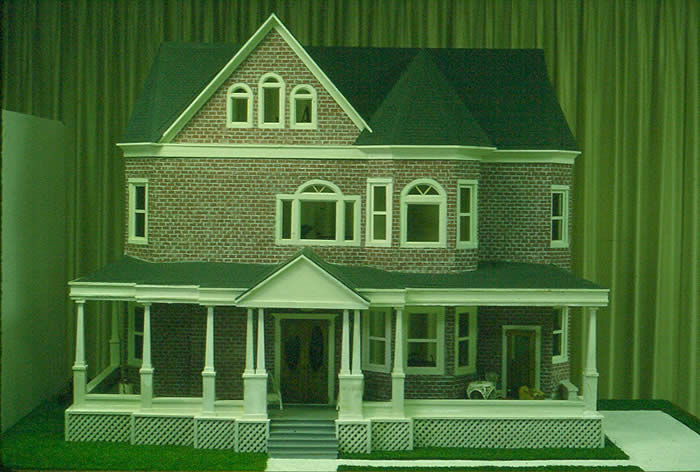
Phase |
Plan |
Result |
|
Meredith Hayden Doll House
Limited Edition 3
$1,300 each |
Edition of 3, $1350 each |
|
Prototype by Olszewski |
Same |
|
By Olszewski |
Better Quality
Plan the Prototype |
|
Sold to 2 Collectors and 1 Shop |
Same |
|
|
|
|
|
$6,500 Resale |
G Collector Purchases |
|
$6,500 Purchase |
Comments: The original prototype I made for my daughter was not quite up to the same standard I had reached on the edition of 3 I had built following it. Lamenting this, I was determined to find one of the pieces I had built in 1973. It took me sometime and I finally located one in Virginia. With the help of my brother and a good trade for his efforts of the prototype, I purchased the piece back I sold for $1,350 for $6,500. To this day, I have no idea where the remaining two of the editions are located.
H2 Long-Term Resale Value Impacted by: |
Production Problems cut projected edition short. |
ERA II 1977 -1979 Pre-Goebel "Lady with a Fan "
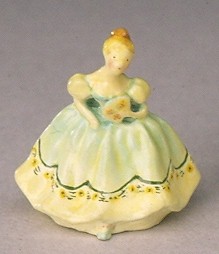
Phase |
Plan |
Result |
A Concept |
Reproduction of an original Royal Doulton in 1/12 scale.
Edition at least 100 |
Same |
B Master Sculpt |
Olszewski |
Same |
C Production |
Paul Geffre Caster
Olszewski |
Because of difficulty with the mold due to the fan detail only 29 pieces were produced and the piece was retired |
D Distribution |
Sold to my list of collectors that bought 1 of each new painted work I did. |
Olszewski sold to collectors for $35.00 each |
E Shop Sales |
N/A |
|
F Collector Sales |
I expected to be able to paint and fulfill the orders to the 100 collectors that were in my automatic list, and even beyond to dealers. |
To be fair, the list of 100 collectors was followed in the order that people signed up by date. The first 29 people got the piece and collectors after #29 did not. All pieces were fully signed and notated by hand sequentially from #1/29 to 29/29. Collector Sales $5,000.00 |
G Collector Purchases |
|
Collector Purchase $5,000.00 |
Comments: This was my first experience at having production problems dictate the size of a production run. The piece originally sold for $35 in 1977 and has resold for $5,000 at the last reported sale recorded in 1998.
H3 Long-Term Resale Value Impacted by:
|
Shipping Damage to Display and Market Demand was Greater for Figurines than the Display |
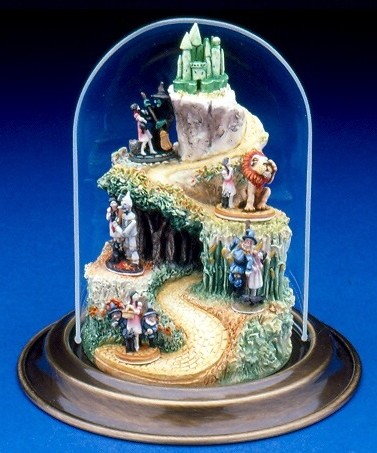
ERA III 1979 - 2004 Goebel Miniatures "Wizard of Oz" Display
Phase |
Plan |
Result |
A Concept |
Resin display for the 1984-1988 Wizard of Oz Collection. Issue Price $60.00. |
Resin Display |
B Master Sculpt |
Olszewski and Staff |
Castle Top was carved too thin and a very high 30 percent were broken in transit. First run made was 2,500. |
C Production |
Goebel Miniatures
Overseas |
Overseas production facility destroyed the master and a 2nd production run would not have been possible. |
D Distribution |
Miniature Shops
Collectible Shops |
|
E Shop Sales |
|
Miniature Collectors were content to place the Oz figures in room settings and didn't want the display. |
F Collector Sales |
|
Collector Sale $400.00 |
G Collector Purchases |
|
Collector Purchase $400.00 |
Comments: This was a perfect storm of 3 major problems determining the resale market. We had full intentions of producing the full 5,000 piece run, but since the miniature collectors didn’t want the display, we didn’t see the need to redesign or repair the display for a second run. If the collectors would have wanted it, we would have somehow overcome the problem. This is a great example of collectors impacting the resale value. Today, the piece is very hard to find and with 2,500 collectors not able to complete their collection, the display will always hold its value and more.
H4 Long-Term Resale Value Impacted by:
|
Collectors of only the "Dopey" character broke up sets of the Seven Dwarfs and made the Seven Dwarf sets difficult to complete. |
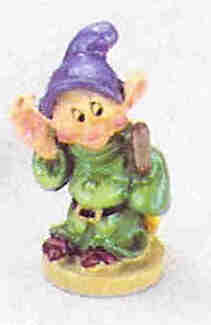
ERA III 1979 -2004 Goebel Miniatures "Dopey" From Snow White Set
Phase |
Plan |
Result |
A Concept |
Grolier Commission for celebrating the 50th Anniversary of Snow White world wide subscription 27,500 pieces sold individually. Dopey for the Grolier issue price was $60.00. |
Same |
B Master Sculpt |
Olszewski and Staff |
Same |
C Production |
Goebel Miniatures |
Same |
D Distribution |
Grolier and Goebel USA |
Same |
E Shop Sales |
1,000 Shops U.S. |
Same |
F Collector Sales |
|
Dopey is hardest dwarf to find. No verifiable sale.
|
G Collector Purchases |
|
No verifiable purchase information available |
Comments: In the production runs as best as I recall, all the dwarfs were run equally. The sets were sold at Grolier as a subscription offer which would purchase all 7 dwarfs, Snow White and the Display. When the Grolier offer ended, the sales to the shops began, little did we know that with the dwarfs being sold separately, collectors could purchase as they wish. As a result, many Dopey collectors broke the sets up and only purchased Dopey, leaving many sets incomplete. Today, try and find Dopey by himself. It will be next to impossible to complete your set. As you know it will be hard to buy just that one Dopey from a collector as well. Another set breaker is Tinkerbell and we have found that in the Story-Time Peter Pan that Tinker collectors have already made the Peter Pan sets difficult to complete.
H5 Long-Term Resale Value Impacted by:
|
| Distributors Ordered too little to satisfy the Collector Demand |
ERA III 1979 - 2004 Goebel Miniatures M.I. Hummel Kinderway
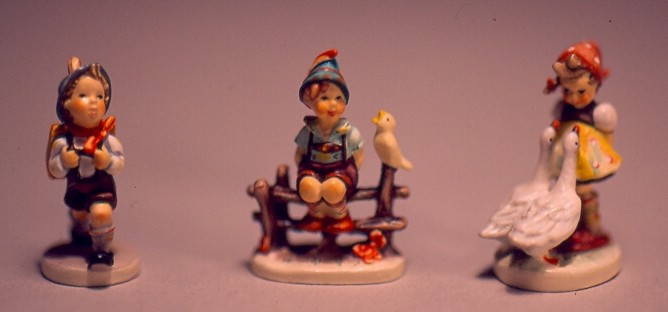
| Phase |
Plan |
Result |
A Concept |
Reproduction of 3 M.I. Hummel figurines to complete Kinderway program of F.E. 10,000 |
First Edition 3,000 |
B Master Sculpt |
Olszewski |
Olszewski |
C Production |
Goebel Miniatures |
It was at the end of this program and since sales were tapering off due to market reordering, production was cut back severely. One distributor (Schmid) went out of business before a reorder could be placed. |
D Distribution |
Goebel USA
Schmid |
|
E Shop Sales |
1,000 US Dealers |
|
F Collector Sales |
|
|
G Collector PUrchases |
|
No verifiable purchase |
Comments: The first editions 10,000 of the Kinderway Program sold out and even 2nd edition of up to 4,000 were sold setting the number of at least 14,000 people who were collecting Kinderway. With the Schmid order cut back, only 3,000 of each were ever produced. Consequently 11,000 collectors will never be able to complete their collections. No resale prices have been reported to us but collectors continually report how hard these are to find. This is a great example that edition size is not the only way to establish values. Even an edition of 3,000 can be sought after if 11,000 collectors are looking for it.
H6 Long-Term Resale Value Impacted by:
|
The strong premier concept was sold to only those who attended the event and edition was sold out leaving no opportunity for discounting below the issue price. |
ERA IV Olszewski Studios 1994 - Today "Steamboat Willie"
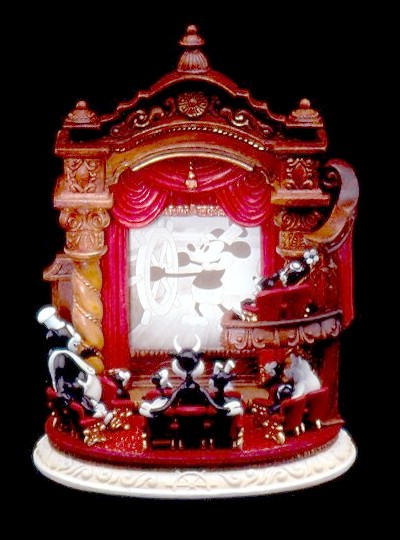
Phase |
|
|
A Concept |
Commission to do a piece like Enchanted Places figures, Price $125.00 Edition 100 Bronze
|
Olszewski Concept: "Steamboat Willie" on movie screen with cast attending premier in Pewter/Resin
|
Olszewski Concept of Movie Premier was accepted |
B Master Sculpt |
|
|
|
C Production |
|
Same |
|
D Distribution |
2001 Disneyanna Convention
|
N/A |
2001 Disneyanna Convention Edition sold out
Edition 500
Issue Price $250.00
|
E Shop Sales |
|
N/A |
|
F Collector Sales |
|
|
|
G Collector Purchases |
|
|
Collector Purchase $750.00 |
Comments: This was so perfect an execution of a concept as possible. The concept was strong and the edition and price selected by Disney were just right for the audience and its size. No discount was able to occur and investor collectors resold the piece for a good value.
H7 Long-Term Resale Value Impacted by: |
Distribution efforts were not enough to sustain a business model |
ERA IV Olszewski Studios 1994 - Today "Story-Time Line"
Phase |
|
|
A Concept |
Do all Disney stories start to finish. Completing story with movie premier Grand Finale. |
Except for Winnie the Pooh, line ended before stories were completed. |
B Master Sculpt |
Olszewski and Staff |
Same |
C Production |
Olszewski Staff |
Same |
D Distribution |
by Olszewski Studios |
Disney ended distribution license with Olszewski Studios. Harmony Kingdom accepted licensing responsibilities retaining Olszewski as the artist.
Harmony was not able to expand distribution large enough to support a business model. |
E Shop Sales |
|
Dealers were caught off guard and are focused on selling remaining inventories. |
F Collector Sales |
|
Collectors were caught off guard and are filling in stories. |
G Collector Purchases |
|
No verifiable information available |
Click here to read the Harmony Ball Announcement and Olszewski's Personal Response.
THE FOLLOWING ARE READER RESPONSES
Posting 12/11/06
I very much appreciate Mr. Olszewski's views on the resale market. I began
collecting when members of my club came home from the NAME houseparty in
Washington, DC in about 1979 or 1980. I was able to collect one pre-Goebel
without a box at a Philadelphia show and have purchased many of the Goebel
pieces (one at a time from the grocery budget). I just learned to navigate
ebay in August of this year and have managed to finish some of my
collections. I am not yet sure how I feel about the values that seem like
bargains but nothing can dim my love of these figures and the joy I felt in
aquiring them little by little. Thank you for providing this valuable
assistance and thank you for creating the beautiful Goebel nativity.